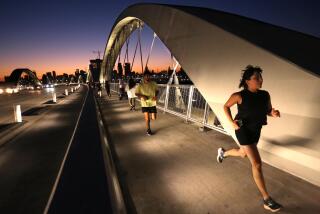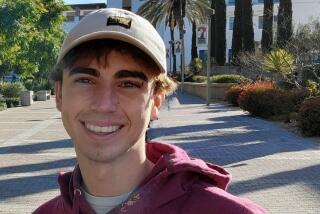THEY’RE GOING FULL CYCLE : With Big Event This Weekend, SDSU Club Has Pedals to Metal
- Share via
SAN DIEGO — Stig Nybo and Robert Bingham, two San Diego State University students, haven’t had a lot of time to study this semester.
It’s not so bad for Bingham, a junior majoring in marketing. But for Nybo, it’s not good. He’s a graduate student in exercise physiology, and besides his course work, he teaches three activity classes.
The two don’t seem worried, though--something else is on their minds right now.
The SDSU Cycling Club is playing host to the SDSU/Pepsi Cycling Classic this weekend, and Bingham and Nybo, two club officers, have spent the better part of the past two months preparing for it.
Bingham, second-year president of the club (which is not funded by the university), has spent so much time preparing for this event that he has completely forgotten his training.
“Not since Christmas,” he says. “I ride to school, that’s about it.”
Part of Nybo’s problem is that he hasn’t given up his training, putting in 20 hours a week on the road despite an injury. He also has been spending about 30 hours a week organizing this weekend’s races, for which he is director. He doesn’t sleep much.
The event will be Saturday and Sunday, with racing in four men’s and two women’s categories each day beginning at 8 a.m. Saturday, in the hills near Jamul in east San Diego County, riders will compete over a 16-mile loop course on Skyline Drive and Lyons Valley Road that includes 3,000 feet of climbing every lap. The top race, Men’s Category A, is the first and longest race (46.5 miles).
Sunday, racers will compete on a .7-mile course over Hardy Avenue, Campanile Drive, Lindo Paseo Road and 55th Street around San Diego State’s fraternity row. The criterium-style races will run from 22 to 50 laps depending on the division. The top division--Men’s A--is a 50-lap, 35-mile race beginning at 1:30 p.m., the weekend’s final event.
With all this going on, Nybo, Bingham and the team’s Category A captain, Brent Witters, still found a little time Monday to talk about college racing, this event and the development and support of the SDSU Cycling Club.
Bingham says the club has been among the best in the Western Collegiate Cycling Conference for the past 10 years. “We’ve been a sport club on campus for at least that long,” he said. “We’ve never gotten that large because in collegiate cycling, you don’t race for money, you race for points, and that doesn’t attract the media and attention that money does. But the sport has picked up a lot.”
There are 52 members in the SDSU club, which competes in weekend races from February to May in the WCCC. The 10-year-old conference, the nation’s largest, comprises 32 teams from California. SDSU placed eighth overall last season and won the WCCC track championships (as opposed to the road, criterium and time trial competitions). During the off-season, the team competes in United States Cycling Federation races.
“Collegiate cycling is a big training ground for racing,” Bingham said. “People who race in collegiate cycling races don’t have to have a license by the USCF.”
Added Nybo: “It’s not as competitive as the USCF. (College cycling) offers entry level racing for cyclists who really haven’t been introduced to cycling. They can come in, and it’s not as intimidating (as USCF races), and you get to see the same riders over and over again from different schools.”
College cycling got its start more than 30 years ago on the East Coast, but a number of new conferences have been springing up recently. Those in Colorado, Texas and the Southwest are just a few years old, and ones in Oregon and Washington are in their first years.
Bingham, the WCCC representative to the U.S. Collegiate Cycling Assn., says rules are different in each conference. In the WCCC, there are four riding categories for men (A through D) and two for women (advanced and novice).
The WCCC hasn’t always been that organized according to Witters, a senior majoring in aerospace engineering and in his fifth year with the club.
“The league has just expanded immensely,” he said. “There are five times as many riders and teams. (In the past) it was a lot more kickback, relax and have a good time doing it and don’t worry about the results. As far as sponsorship, we didn’t have anything in the past, everybody out of their own pockets, $15 worth of dues and go do your own thing. We would get together and car-pool up there and do a race.”
Since the SDSU club is not university-funded, members still dig pretty deeply into their pockets to make it work. Each member now pays $45 per year in dues, $15 to the recreation sports office to cover insurance, $8 per race (not event, but race) and about $40 in gas and food whenever the club travels. Trips are scheduled for Stanford, Cal Poly-San Luis Obispo and Cal this season.
“When you figure the average cost of a bike is $1,000, it can tap your pocketbook,” Nybo said. “We are really fortunate to have some sponsors supporting us.”
Some? Only the U.S. Olympic team seems to be sponsored better. Twelve companies provide the SDSU club with everything from bikes to cycle wear and nutrition.
“Schwinn gives us bikes for our A team,” said Bingham, who had a major hand in corralling such support. “ST Cyclewear gives us about $10,000 worth of clothing each year.
“We’re definitely the largest as far as sponsorship goes. We’re probably two years ahead of any team as far as getting sponsors. Each year, we keep getting larger and larger.”
Bob Hagen, SDSU’s recreation sports manager, acts as a consultant to club teams in areas such as organization and sponsorship.
“The sponsorships that these sport clubs get are really essential to their success and their ability to attract athletes,” Hagen said. “The success is based on the student-athletes who are members of the club. They go out and do all the leg work for travel arrangements and get people to sponsor their teams. Each of the clubs rely on three or four really key people who help keep it organized.”
Sometimes Nybo and Bingham aren’t so sure about the organization part. They recently had a meeting to organize volunteer help for the courses this weekend. Only about 10 club members showed up.
“There is a certain commitment that needs to be made for a team,” Nybo said. “It’s a volunteer organization, and we need a commitment from everybody. There is a problem with people volunteering their time. It does rest on the shoulders of the few.”
Those problems aside, there is a good feeling about the talent on the club.
“This year we have a really good team that could place among the top (in the WCCC),” said Witters, who placed third at last weekend’s USD Grand Prix and is one of SDSU’s top criterium riders.
Other top riders for the club, which is coached by Richard Bryne, are Jeff Wade Jr., Chris Best, Chase Watts, Dean Meyer and Nybo among the men and Sian Williams, Stephanie Lucero, Carol Kaune and Holly Stevenson among the women.
Regardless of the success on the course, the success of the club is solely in the hands of the club members.
“It really comes down to the students who are actually running the club,” Hagen said. “They are the ones who have to be on the ball and be willing to put in the extra time and effort and promote it and market it and work with all the different entities throughout the university. It’s like a job.”


